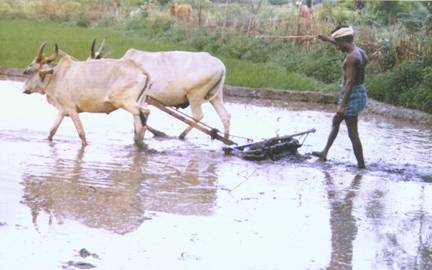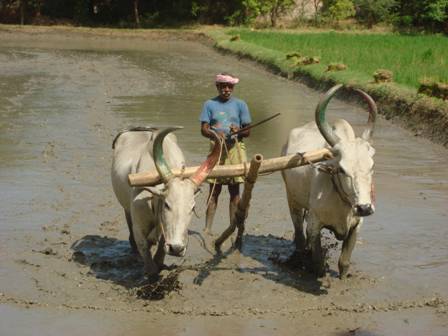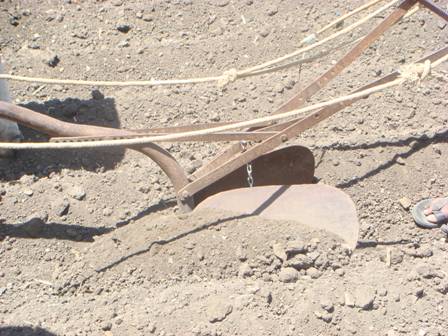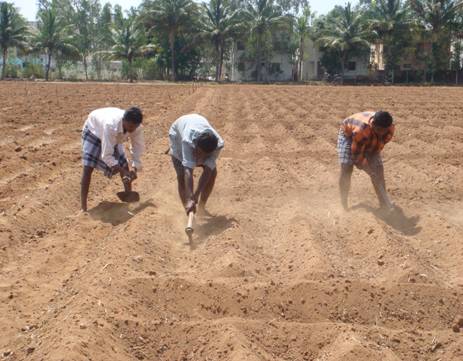
|
|||||||||||||||||
| Home | Seasons & Varieties | Tillage | Nutrient Mgmnt | Irrigation Mgmnt | Weed Mgmnt | Crop Protection | Cost of Cultivation | Photobank | |||||||||||||||||
Tillage :: Tillage Operations for Field Crops |
|||||||||||||||||
RICE (Oryza sativa L.) Transplanted Puddled Lowland Rice Forming Seedbeds
Dry nursery
Main Field Management
Keep water to a depth of 2.5cm at the time of puddling SYSTEM OF RICE INTENSIFICATION (SRI)
Main field preparation
WET SEEDED PUDDLED LOWLAND RICE Wet Seeded Rice
Land levelling DRY SEEDED RAINFED UN-PUDDLED LOWLAND RICE
DRY SEEDED RAINFED UN-PUDDLED LOWLAND RICE WITH
DRY SEEDED IRRIGATED UN-PUDDLED LOWLAND RICE
MILLETS Nursery Preparation Laying The Nursery Main Field Preparation for Irrigated Crop Ploughing To overcome the subsoil hard pan in Alfisols (deep red soils) chiselling the field at 0.5 m intervals to a depth of 40 cm on both the directions of the field followed by disc ploughing once and cultivator ploughing twice help to increase the yield of sorghum and the succeeding blackgram also. This was true with Sorghum followed by Groundnut also. Application of FYM and 100% of recommended N can also be followed. In soils with sub-soil hard pan, chiselling should be done every year at the start of the cropping sequence to create a favourable physical environment. Formation of Ridges and Furrows
RATOON SORGHUM CROP
CUMBU (Pennisetum glaucum (L) R. Br. ) Preparation of Land
PREPARATION OF MAIN FIELD Field Preparation
Forming Ridges and Furrows/Beds
RAGI (Eleusine coracana) IRRIGATED Preparation of Nursery (Irrigated Transplanted Crop) Preparation of Land
Forming Raised Bed
Preparation of Main Field Ploughing the Field Plough twice with mould board plough or thrice with wooden plough till a good tilth is obtained. Forming Beds and Channels
RAGI : RAINFED Tillage MAIZE (Zea mays L.) IRRIGATED MAIZE Field Preparation Plough the field with disc plough once followed by cultivator ploughing twice, after spreading FYM or compost till a fine tilth is obtained. Forming Ridges and Furrows or Beds
RAINFED MAIZE Field Preparation Chisel the soil having hard pan formation at shallow depths with chisel plough at 0.5 M interval first in one direction and then in the direction perpendicular to the previous one once in three years. Apply 12.5 t/ha of FYM or compost or composted coir pith besides chiselling, to get an additional yield of about 30% over control. Tenai
Samai
Varagu
WHEAT (Triticum aestivum.) Field Preparation Plough twice with an iron plough and two to three times with cultivator and prepare the land to a fine tilth. Forming Beds and Channel Form beds of size 10 m2 or 20 m2. The irrigation channels are to be provided sufficiently. PULSES REDGRAM ( Cajanus cajan (L.) Millsp. ) Management of Field Operation Preparation of the Land BLACKGRAM ( Vigna mungo L.)
GREENGRAM ( Vigna radiata L. )
COWPEA ( Vigna unguiculata (L.) Walp.aggreg.) Prepare the land to fine tilth and form beds and channels. HORSEGRAM ( Macrotyloma uniflorum ) Prepare the land to a fine tilth. BENGALGRAM ( Cicer arietinum L.) Prepare the land to fine tilth and apply 12.5 t FYM/ha GARDEN LAB LAB (AVARAI) Prepare the land to fine tilth. Form beds and channels for bushy types. FIELD LAB-LAB (MOCHAI) Management of Field Operations Prepare the land to fine tilth. SOYBEAN ( Glycine max (L.) Merr.) Management of Field Operations Prepare the land to get fine tilth and form beds and channels. RAINFED SOYABEAN If herbicide spray is not given, two hand weeding on 20 and 35th day after sowing. SWORD BEAN ( Canavalia gladiata L.) OILSEEDS I. Rainfed
Forming Beds
Earthing Up Accomplish earthing up during second hand weeding/late hand weeding (in herbicide application).
Irrigated
Forming Beds
Earthing up: Accomplish earthing up during second hand weeding/late hand weeding (in herbicide application). NOTE: i) Earthing up provides medium for the peg development. ii) Use the improved hoe with long handle which can be worked more efficiently in a standing position. iii) Do not disturb the soil after the 45th day of sowing as it will affect pod formation adversely. SESAME (Sesamum indicum) Field Preparation
CASTOR (Ricinus communis) Preparation of the Field Plough two-three times with country or mould board plough. SAFFLOWER (Carthamus tinctorius)Preparation of the Field
SUNFLOWER ( Helianthus annuus ) Field Preparation Plough once with tractor or twice with iron-plough or three to four times with country-plough till all the clods are broken and a fine tilth is obtained. Forming Ridges and Furrows
OILPALM NIGER (Guizotia abyssinica) Preparation of the Field Field Preparation
COTTON Preparation of Field for Irrigated Cotton Crop Preparation of The Field
Formation of Ridges and Furrows
Rectification of Ridges and Furrows Reform the ridges and furrows after first top dressing in such a way that the plants are on the top of the ridges and well supported by soil. RICE FALLOW COTTON Preparation of the Field
Formation of Ridges Old delta
New delta
Note: In case of zinc deficient soils, apply 50 kg ZnSo4 /ha RAINFED COTTON Preparation of The Field
Adopt permanent broad ridges system. JUTE ( Corchorus olitorius & Corchorus capsularis ) Land Preparation: Fine tilth is required since the seeds are very small. AGAVE – CULTIVATION Preparation of the Field a) Wetland (Heavy soils): In wetlands, preparatory cultivation by ploughing the land and bringing the soil to fine tilth could not be done.
b) Problem soils with excessive soil moisture: In problem soils, with excessive moisture where it is difficult to drain water, form raised beds at 30 cm intervals with Length - 5 m, Width - 80 cm, and Height -15 cm.
In medium and light soil irrigated by flow or lift irrigation adopt the following:
Earthing Up After application of 3rd dose fertilizer (90 days), work victory plough along the ridges for efficient and economical earthing up. At 150 days after planting, earthing up may be done with spade. SWEET SORGHUM (Sorghum bicolor) Farm Land PreparationForm ridges and furrows at a spacing of 45 cm apartTROPICAL SUGARBEET Field preparation Well drained sandy loam and clayey loam soils having medium depth (45” cm) with fairly good organic status are suitable. Tropical sugarbeet require deep ploughing (45 cm) and followed by 2 – 3 ploughing to obtain a good soil tilth condition for favorable seed germination. Ridges and furrows are formed at 50 cm apart. FORAGE CROPS FODDER CHOLAM IRRIGATED CHOLAM Ploughing Plough with an iron plough once and with a country plough twice. Forming Ridges and Furrows Form ridges and furrows of 6 m long and 60 cm apart and plant on either side of the ridge FODDER CUMBU Preparatory Cultivation Plough with an iron plough once and with a country plough twice. FODDER MAIZE Ploughing Plough the field twice with an iron plough and three or four times with country plough. Forming Ridges and Furrows Form ridges and furrows using a ridger, 30 cm apart are form beds of size 10 m2 or 20 m2 depending on the availability of water and slope of the land. NEELAKOLUKATTAI (BLUE BUFFEL GRASS) - (Cenchrus glaucus) Ploughing Plough the field twice or thrice with an iron plough to ensure good tilth. GUINEA GRASS (Panicum maximum) Preparatory Cultivation Plough 2 to 3 times to obtain a good tilth and form ridges and furrows at 50 cm spacing. Preparatory Cultivation Plough 2-3 times to obtain good tilth and form beds and channels. CUMBU - NAPIER HYBRIDS Ploughing Plough with an iron plough two to three times to obtain good tilth. LUCERNE – KUDIRAI MASAL (Medicago sativa) Ploughing Plough three or four times with country plough to obtain good tilth. Forming Beds Form beds of size 10 m2 or 20 m2 depending on the availability of water and slope of land. HEDGE LUCERNE - VELIMASAL ( Desmanthus virgatus ) Ploughing Plough two to three times with an iron plough to obtain good tilth. Forming Ridges and Furrows Form ridges and furrows 50 cm apart using ridger and irrigation channels across furrows. FODDER COWPEA Ploughing Forming Ridges and Furrows
Preparatory Cultivation Ploughing Plough the field two to three times to obtain good tilth. Forming Beds Form beds of size 10 m2 or 20 m2 LEUCAENA – SOUNDAL ( Leucaena leucocephala ) Ploughing Plough twice with an iron plough and 3 or 4 times with country plough to obtain good tilth. Forming Ridges and Furrows Form ridges and furrows (using a ridger) 6 m along and 1 m apart and irrigation channels across the furrows. Updated on : 10.06.2013 |
|||||||||||||||||
| Home | Seasons & Varieties | Tillage | Nutrient Management | Irrigation Management | Weed Management | Crop Protection | Cost of Cultivation | © All Rights Reserved. TNAU-2016. |
|||||||||||||||||




